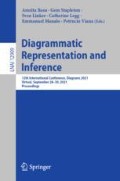Abstract
Combining and relating logical diagrams is a relatively new area of study in the community of people who work on Aristotelian diagrams. Most attempts now have been relatively ad hoc. In this paper I outline a more systematic research program inspired by a category-theoretic perspective. As concerns the logical diagrams, I will mainly focus on the Demey–Smessaert tradition.
I would like to thank Lorenz Demey for his valuable help and support. I would also like to thank Sylvia Wenmackers, Wouter Termont, and the BITSHARE-team. I acknowledge my doctoral fellowship of the Research Foundation Flanders (Fonds Wetenschappelijk Onderzoek, FWO) through Grant Number 1139420N.
Access this chapter
Tax calculation will be finalised at checkout
Purchases are for personal use only
Notes
- 1.
A good introduction to Boolean algebras can be found in Givant and Halmos [4].
- 2.
Given that the use of category theory is relatively novel to most philosophers, I would like to point the interested reader to Awodey’s superb primer [1].
- 3.
In philosophical logic, one calls the following axiom ‘modal collapse’: \(\Diamond \varphi \rightarrow \Box \varphi \).
- 4.
In this paper, we only consider cases where the fragments (as per usual) exclude the top and bottom elements of the algebra. If one wishes to include them, however, only the obvious and desired (!) relations are induced by the constructions. Mutatis mutandis, all the proofs yield the same well-behaved results —with a proviso in Lemma 1. The tweaks just involve the consideration of the special cases involving the top and bottom elements.
References
Awodey, S.: Category Theory. Oxford University Press, Oxford (2010)
Demey, L., Smessaert, H.: Combinatorial bitstring semantics for arbitrary logical fragments. J. Philos. Log. 47(2), 325–363 (2018)
Demey, L., Steinkrüger, P.: De logische geometrie van johannes buridanus’ modale achthoek. Tijdschrift voor Filosofie 79(2), 217–238 (2017)
Givant, S., Halmos, P.: Introduction to Boolean Algebras. Springer, New York (2009). https://doi.org/10.1007/978-0-387-68436-9
Pizzi, C.: Generalization and composition of modal squares of oppositions. Log. Univers. 10(2), 313–325 (2016)
Smessaert, H., Demey, L.: Logical geometries and information in the square of oppositions. J. Logic Lang. Inform. 23(4), 527–565 (2014)
Author information
Authors and Affiliations
Corresponding author
Editor information
Editors and Affiliations
Rights and permissions
Copyright information
© 2021 Springer Nature Switzerland AG
About this paper
Cite this paper
Vignero, L. (2021). Combining and Relating Aristotelian Diagrams. In: Basu, A., Stapleton, G., Linker, S., Legg, C., Manalo, E., Viana, P. (eds) Diagrammatic Representation and Inference. Diagrams 2021. Lecture Notes in Computer Science(), vol 12909. Springer, Cham. https://doi.org/10.1007/978-3-030-86062-2_20
Download citation
DOI: https://doi.org/10.1007/978-3-030-86062-2_20
Published:
Publisher Name: Springer, Cham
Print ISBN: 978-3-030-86061-5
Online ISBN: 978-3-030-86062-2
eBook Packages: Computer ScienceComputer Science (R0)

